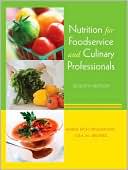Nutrition for Foodservice and Culinary Professionals
Search in google:
The culinary professional’s foundational guide to nutrition and healthful eating With increased consumer awareness of healthy eating, chefs and restaurateurs are expected to provide healthy offerings to their customers. Expanded in size as well as content, the Seventh Edition of Nutrition for Foodservice and Culinary Professionals continues to fulfill its reputation as the essential reference to nutrition and foods for culinary students and professionals.This practical book is tailored to the needs of culinary and hospitality students and professional who need to use nutritional principles to evaluate and modify menus and recipes, as well as to respond knowledgeably to customers' questions and needs. It introduces the reader to nutrition and foods including using the Dietary Guidelines, MyPyramid, and food labels to plan menus; provides advice on how to develop healthy recipes and menus; relates nutrition to health problems such as obesity and heart disease; and discusses how to address nutrition concerns from pregnant mothers to the elderly. Even more user-friendly and up-to-date than previously, this Seventh Edition’s noteworthy updates include:A new, interactive diet and activity software program called Culinary Nutrition Manager that enables readers to create, modify and analyze the nutritional content of recipes as well as analyze their own dietsNew, visual design that allows for additional photos, drawings, menus, and tables to more effectively convey nutrition concepts and applicationsTwo new features, Nutrition Science Focus and Culinary Science, that provide the reader with additional nutritional science informationDiscussion of current issues related to childhood obesity, the impact of diet on the environment, organic foods, superfoods, botanicals, and herbsIn-depth information on relevant food-related topics such as trans fats, beverage choices, food allergies, and new sugar substitutesExpanded coverage on carbohydrates include the glycemic response and its relationship to health issuesBalanced menu items, recipes, and Chef's Tips on preparing all mealsInformation on the basic principles of food presentation and garnishesComprehensive chapter on weight management, including obesity statistics in the United States, and information on weight loss drugs and surgeryAn updated Nutrition Web Explorer with specific food and nutrition related information from selected website sourcesPractical appendices including a listing of nutritive values of common foods consumed in the U.S., Dietary Reference Intakes for individuals by age, and growth charts from birth to 20 years
Preface. PART ONE: FUNDAMENTALS OF NUTRITION & FOOD. Chapter 1: Introduction to Nutrition. Factors Influencing Food Selection. Flavor. Other Aspects of Food. Demographics. Culture and Religion. Health. Social and Emotional Influences. Food Industry and the Media. Environmental Concerns. Basic Nutrition Concepts. Nutrition. Kilocalories. Nutrients. Nutrient Density. Characteristics of a Nutritious Diet. Nutrient Recommendations: Dietary Reference Intakes. What Happens When You Eat. Digestion, Absorption, and Metabolism. Gastrointestinal Tract. Food Facts: How to Recognize Whole Foods, Processed Foods, and Organic Foods. Hot Topic: How the American Diet Impacts the Environment and How Restaurants are Going Green. Chapter 2: Using Dietary Recommendations, Food Guides, and Food Labels to Plan Menus. Dietary Recommendations and Food Guides. Dietary Guidelines for Americans. MyPyramid. Food Labels. Nutrition Facts. Nutrient Claims. Health Claims. Portion Size Comparisons. Food Facts: Nutrient Analysis of Recipes. Hot Topic: Quack! Quack! Chapter 3: Carbohydrates. Functions of Carbohydrates. Simple Carbohydrates (Sugars). Monosaccharides. Disaccharides. Added Sugars. Health Issues. Complex Carbohydrates (Starches and Fibers). Starches. Health Effects of Starches. Fibers. Health Effects of Fibers. Nutrition Science Focus: Carbohydrates. Digestion, Absorption, and Metabolism of Carbohydrates. Dietary Recommendations for Carbohydrates. Ingredient Focus: High-Fiber Grains and Legumes. Grains. Culinary Science. Chef’s Tips. Legumes. Chef’s Tips. Food Facts: Foods and the Glycemic Index. Hot Topic: Alternatives to Sugar: Artificial Sweeteners and Sugar Replacers. Chapter 4: Lipids: Fats and Oils. Functions of Lipids. Nutrition Science Focus: Lecithin. Triglycerides. Nutrition Science Focus: Triglycerides. Triglycerides in Food. Trans Fats. Essential Fatty Acids: Omega-3 and Omega-6 Fatty Acids. Cholesterol. Digestion, Absorption, and Metabolism. Nutrition Science Focus: Lipoproteins. Lipids and Health. Heart Disease. Cancer. Dietary Recommendations. Ingredient Focus: Milk, Dairy Products, and Eggs. Nutrition. Culinary Science. Chef’s Tips. Food Facts: Oils and Margarines. Hot Topic: Trans Fats in Restaurants. Chapter 5: Protein. Structure of Protein. Functions of Protein. Nutrition Science Focus: Protein. Digestion, Absorption, and Metabolism. Protein in Food. Health Effects of Protein. Dietary Recommendations for Protein. Ingredient Focus: Meat, Poultry, and Fish. Nutrition. Culinary Science. Chef’s Tips. Food Facts: Soy Foods and Their Health Benefits. Hot Topic: Irradiation. Chapter 6: Vitamins. Characteristics of Vitamins. Fat-Soluble Vitamins. Vitamin A. Nutrition Science Focus: Vitamin A. Vitamin D. Nutrition Science Focus: Vitamin D. Vitamin E. Nutrition Science Focus: Vitamin E. Vitamin K. Nutrition Science Focus: Vitamin K. Water-Soluble Vitamins. Vitamin C. Nutrition Science Focus: Vitamins C. Thiamin, Riboflavin, and Niacin. Nutrition Science Focus: Thiamin, Riboflavin, and Niacin. Vitamin B6. Nutrition Science Focus: Vitamin B6. Folate. Nutrition Science Focus: Folate and Vitamin B12. Vitamin B12. Pantothenic Acid and Biotin. Choline and Vitaminlike Substances. Ingredient Focus: Fruits and Vegetables. Nutrition: Health Benefits of Fruits and Vegetables. Culinary Science. Chef’s Tips. Food Facts: Functional Foods: Superfoods. Hot Topic: Phytochemicals. Chapter 7: Water and Minerals. Water. Functions. How Much Water Do You Need? Bottled Water. Major Minerals. Calcium and Phosphorus. Nutrition Science Focus: Calcium and Phosphorous. Magnesium. Nutrition Science Focus: Magnesium. Sodium. Potassium. Chloride. Other Major Minerals. Nutrition Science Focus: Water and Electrolytes. Trace Minerals. Iron. Zinc. Nutrition Science Focus: Zinc. Iodine. Selenium. Fluoride. Chromium. Copper. Other Trace Minerals. Ingredient Focus: Nuts and Seeds. Nutrition. Culinary Science. Chef’s Tips. Food Facts: How to Retain Vitamins and Minerals from Purchasing to Serving. Hot Topic: Dietary Supplements. Part Two: Developing and Marketing Healthy Recipes and Menus. Chapter 8: Foundations of Healthy Cooking. Flavor. Herbs and Spices. Juices. Vinegars and Oils. Stock. Rubs and Marinades. Aromatic Vegetables. Sauce Alternatives: Vegetable Purees, Coulis, Salsas, Relishes, Chutneys, Compotes, and Mojos. Wine and Spirits. Extracts and Oils. Putting It All Together: Flavor Profiles. Cooking Methods and Techniques for a Healthy Eating Style. Dry-Heat Cooking Methods. Chef’s Tips for Roasting. Chef’s Tips for Broiling and Grilling. Chef’s Tips for Sautéing and Dry Sautéing. Chef’s Tips for Stir-Frying. Moist-Heat Cooking Methods. Chef’s Tips for Moist-Heat Cooking. Chapter 9: Healthy Menus and Recipes. Introduction to Healthy Menus. Recipe Modification. Examples of How to Modify Recipes. Meatloaf. Beef Stew. Hamburger. Chicken Quesadillas. Crab Cakes. Vegatable Lasagna. Chicken Pot Pie. Wontons (Filled Dumplings) Velouté Sauce. Creamy Dressings. Oil and Vinegar Dressings. Carrot Cake. Oatmeal Raisin Cookies. Breakfast. Chef’s Tips for Breakfasts. Appetizers. Chef’s Tips for Appetizers. Soups. Chef’s Tips for Soups. Salads and Dressings. Chef’s Tips for Salads and Dressings. Entrées. Chef’s Tips for Entrées. Side Dishes. Chef’s Tips for Side Dishes. Desserts. Chef’s Tips for Desserts. Morning and Afternoon Breaks. Morning Breaks. Afternoon Breaks. Chef’s Tips for Midmorning and Afternoon Breaks. Presentation. Basic Principles. How to Make Garnishes. Recipes. Chapter 10: Marketing to Health-Conscious Guests. Gauging Customers' Needs and Wants. Adding Healthy Menu Options to the Menu. Promotion. Staff Training. Program Evaluation. Responding to Special Guest Requests. Diet Low in Fat, Saturated Fat, and Cholesterol. Low Sodium (Low-Salt) Diet. Vegetarian Diet. High-Fiber Diet. Low-Lactose Diet. Gluten-Free Diet. Diet Low in Added Sugars. Restaurants and Nutrition-Labeling Laws. Part Three: Nutrition’s Relationship to Health and Life Span. Chapter 11: Nutrition and Health. Nutrition and Cardiovascular Disease. Coronary Heart Disease. Stroke. High Blood Pressure. Menu Planning for Cardiovascular Diseases. Nutrition and Cancer. Menu Planning to Lower Cancer Risk. Nutrition and Diabetes Mellitus. Osteoporosis. Facts and Figures. What Is Bone? Risk Factors. Prevention. Detection. Treatment. Food Facts: Botanicals and Herbs. Hot Topic: Biotechnology. Chapter 12: Weight Management and Exercise. "How Much Should I Weigh?" Health Implications of Obesity. Theories of Obesity. Treatment of Obesity. Eating Plan and Nutrition Education. Exercise. Behavior and Attitude Modification. Social Support. Maintenance Support. Drugs. Surgery. Menu Planning for Weight Loss and Maintenance. The Problem of Underweight. Nutrition for the Athlete. Food Facts: Sports Drinks. Hot Topic: Diet Books. Chapter 13: Nutrition Over the Life Cycle. Pregnancy. Nutrition During Pregnancy. Diet-Related Concerns During Pregnancy. Menu Planning During Pregnancy. Nutrition and Menu Planning During Lactation. Infancy: The First Year of Life. Nutrition During Infancy. Feeding the Infant. Childhood. Nutrition During Childhood. Menu Planning for Children. Adolescence. Nutrition During Adolescence. Menu Planning for Adolescents. Eating Disorders. Anorexia Nervosa. Bulimia Nervosa. Binge Eating Disorder. Female Athlete Triad. Treatment. Older Adults. Factors Affecting Nutrition Status. Nutrition for Older Adults. Menu Planning for Older Adults. Food Facts: Food Allergies. Hot Topic: Childhood Obesity. Appendix A: Nutritive Value of Foods. Appendix B: Dietary Reference Intakes. Appendix C: Expanded Serving Sizes for MyPyramid. Appendix D: Growth Charts. Appendix E: Answers to Check-Out Quizzes. Glossary. Index.







